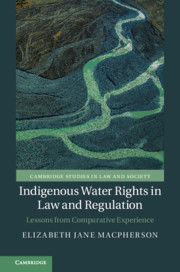Book contents
- Indigenous Water Rights in Law and Regulation
- Cambridge Studies in Law and Society
- Indigenous Water Rights in Law and Regulation
- Copyright page
- Dedication
- Contents
- Acknowledgements
- Chapter One Introduction
- Part I Conceptualising Indigenous Water Rights
- Part II Comparative Country Studies
- Chapter Four The Limited Recognition of Indigenous Water Rights in Australia
- Chapter Five Water Rights for Māori in Aotearoa New Zealand
- Chapter Six Rivers as Subjects and Indigenous Water Rights in Colombia
- Chapter Seven Recognising and Allocating Indigenous Water Rights in Chile
- Part III Lessons Learnt
- Glossary
- Bibliography
- Index
- Cambridge Studies in Law and Society
Chapter Seven - Recognising and Allocating Indigenous Water Rights in Chile
from Part II - Comparative Country Studies
Published online by Cambridge University Press: 20 July 2019
- Indigenous Water Rights in Law and Regulation
- Cambridge Studies in Law and Society
- Indigenous Water Rights in Law and Regulation
- Copyright page
- Dedication
- Contents
- Acknowledgements
- Chapter One Introduction
- Part I Conceptualising Indigenous Water Rights
- Part II Comparative Country Studies
- Chapter Four The Limited Recognition of Indigenous Water Rights in Australia
- Chapter Five Water Rights for Māori in Aotearoa New Zealand
- Chapter Six Rivers as Subjects and Indigenous Water Rights in Colombia
- Chapter Seven Recognising and Allocating Indigenous Water Rights in Chile
- Part III Lessons Learnt
- Glossary
- Bibliography
- Index
- Cambridge Studies in Law and Society
Summary
Chapter 7 examines indigenous water rights recognition and distribution in Chile. In this chapter I discuss the recognition of the ancestral water rights of indigenous peoples under the Indigenous Law and the creation of an Indigenous Land and Water Fund for the acquisition of rights in the market. I argue in this chapter that the recognition of ancestral water rights an incomplete response to the ongoing exclusion indigenous peoples experience from rights allocated within water law frameworks, because it continues to exclude groups that have lost water access to other users.The Fund, by contrast, specifically responds to the situation where indigenous peoples have been unable to continue to exercise their water rights. In the case of water resources already fully allocated to others, the Fund finances the purchase of water use rights in markets for redistribution to indigenous landholders.An interesting lesson from the Chilean experience is that market mechanisms may in some situations be a ‘creative’ response to the injustice in water rights distribution.However, by setting aside a share of water use rights before water resources are already fully allocated, governments reduce the cost of buying-back water use rights for allocation to indigenous peoples in the future.
Keywords
- Type
- Chapter
- Information
- Indigenous Water Rights in Law and RegulationLessons from Comparative Experience, pp. 161 - 212Publisher: Cambridge University PressPrint publication year: 2019
- 1
- Cited by



